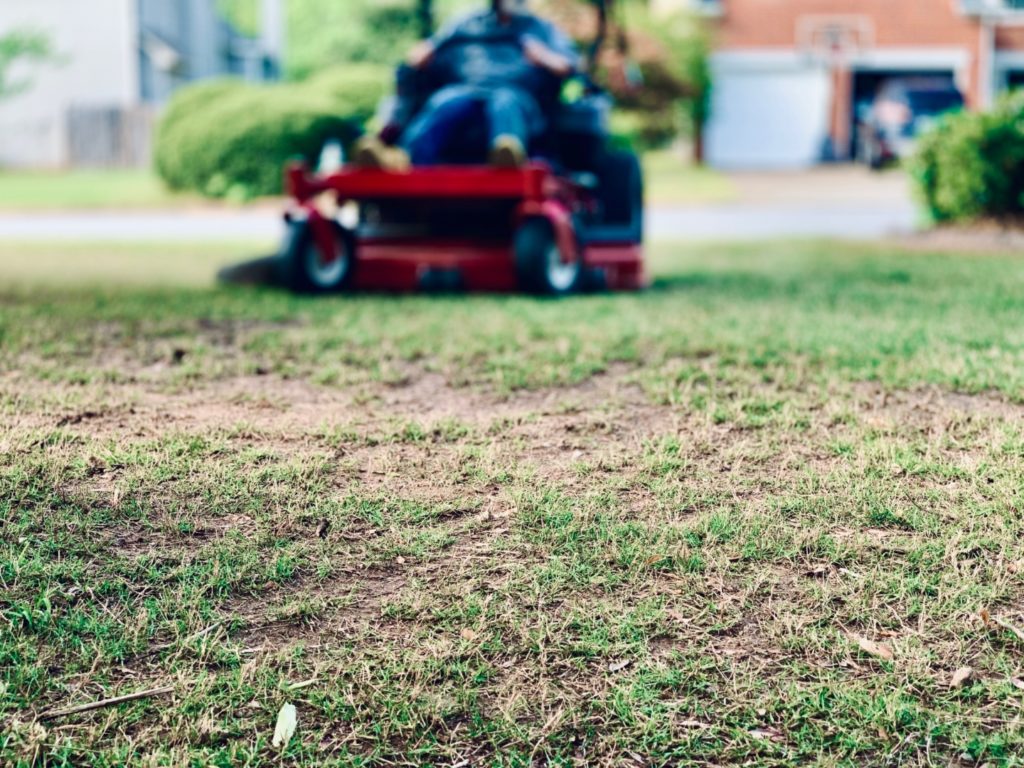Fall Lawn Prep for Winter in the Quad State Area of Southwest Missouri

Posted on November 7, 2022 by Jeremiah Sooter
If you live in the quad-state area of southwest Missouri, you know that grow zone 6 falls into the transition zone, where both cool-season and warm-season turfgrasses thrive. That can mean different nutrient requirements for homeowners looking to complete Fall lawn prep.
Good lawn prep amounts to clearing your lawn of organic matter that could rob your lawn of vital nutrients and water during those winter months. But the right amount of preparation comes down to these four areas:
- Final Fall lawn trim
- Removing dead, dying, or diseased ground-cover
- Apply weed treatment
- Complete Fall fertilizing
Final Fall Lawn Trim

One of the tasks on your Fall lawn prep duties is completing a final mow. It’s essential to conduct the last mowing each year to recommended heights, which vary depending on the grass type growing in your yard.
Warm-Season Turfgrasses
For homeowners with warm-season grasses, adjust your mower’s blade height—or the lawnmower’s deck—to cut your lawn between 2 and 2.5 inches during the Fall season. By doing so, you avoid scalping your lawn as it begins to slow its growth and go dormant for winter. With adjustments in mowing heights throughout a growing season, your springtime growth will result in a thick, healthy green lawn.
Types of Warm-Season Grasses
- Zoysiagrass
- Bermudagrass
Cool-Season Turgrasses
If you have a cool-season lawn, raise your lawnmower decking roughly twice the height used on warm-season turf, cutting to heights of 2.5 to 4 inches. These taller heights encourage deeper root growth that can access water further beneath the surface. To mow cool-season lawns any lower and you also risk weakening the health of your yard, which could lead to the introduction of invasive weeds.
Types of Cool-Season Grasses
- Kentucky bluegrass
- Tall fescues
- Perennial ryegrass
Remove Dead, Dying, or Diseased Ground-cover
Performing a final mow on your lawn inadvertently removes any dead stolons from the surface that failed to root. The cleanup of any dead, dying, or diseased ground cover, such as leaves, weeds, and fallen tree limbs, will help promote a healthier lawn in the Spring.
Apply Weed Treatment
In preparation for those long winter months, you can get a headstart on treating for cool-season weeds, like purple deadnettle (Lamium purpureum) or white clover (Trifolium repens). Applying a weed treatment prevents seeds from sprouting during those warm Fall days while reducing the number of weeds that could sprout in the springtime.
Complete Fall Aeration, Fertilizing, and Top-Dressing
When it comes to winter prep, Fall fertilizing is an important step. But before fertilizing, it’s best to aerate cool-season turfgrasses. Warm-season lawns will spread more aggressively if aerated in late May or early June.
Whether you aerate your lawn by pulling small soil cores or cutting vertical grooves into your grass, spreading fertilizer will enter those small spaces and help provide vital nutrients, which can then be top-dressed using a loose organic material that has a Seal of Testing Assurance, or STA.
Top-dress is a superb way to level out areas of low spots gradually. But don’t smother your lawn with top-dressing. Instead, spread a thin layer across the yard, roughly the depth of ¼ or ½ inch deep.
Fall Lawn Care Services
If you need assistance from an expert in lawn care services, Contact the team at Ground Up Services today at (417) 439-1009, or schedule your next service appointment online!
Their team of experienced lawn professionals has been serving the four-state region for over 15 years and offers a range of services including:
- Drainage Management
- Yard Regrading
- Basement & Foundation Waterproofing
- Landscape Services